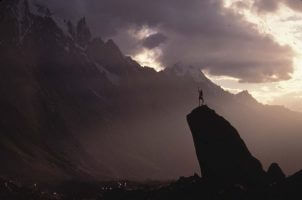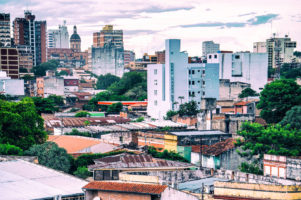Support Hidden Compass
We stand for journalism, science, history, and hope. Make a contribution to Hidden Compass and stand with us.
We would be sitting at home, watching something on TV, or in the kitchen snapping beans for supper, or putting away laundry that was still warm from the sun. And my mother would say, as though it had just come to her, “We came from Mbwaa.”
She would speak wistfully then, her clear brown eyes taking on a faraway glow — as though she had paddled herself to a remote inner sea filled with memories from years long gone, the shoreline of the outer world far behind her.
When she was a child, she and her siblings would huddle around the fire at night, their feet still muddy from the potato farm. They’d lean in as close to their grandmother as they could get, to hear the story of who they were and how everything began.
For Mbwaa is an origin story — a widely told, half-remembered tale of the Ameru people of Kenya. The story would weave in and out of my mother’s mind, so that in the midst of living she would forget it for months on end. Sometimes even years. But on some days, for no reason at all, it would return to her. Just like that.
A dollop from the universe. A memory, a reminder, a responsibility that had become hers. Just as it had been her mother’s, and her mother’s before that, for more than 300 years.
And now it was mine.
“Our ancestors,” my mother would say. “Our ancestors came from Mbwaa.”
Hearing my mother’s shadowy, intermittent memories — recounted in a mellifluous voice that would catch every so often — of who we are and where we came from created a yearning in me for something tangible and deep rooted. But in Kenya today, physical representations of African spirituality and ancient culture can be hard to find.
Oral tradition introduced us to reservoirs of ancient histories, of poetry and song and the spirits of our ancestors — even as our hands cupped empty.
Then I heard about the Ndoro Sculpture Garden — a repository by the sea, hundreds of miles from my home in Nairobi. There the physical representations of another African culture’s spirituality and way of life have been preserved in stone and put on view for all to see.
There my need blossomed into an unquenchable kind of sadness for all that had been lost.
~~
I can see him standing between the shrubs and the thick-barked trees. A man, but not so. Half-hidden in the shade, he’s halfway to something else — in the midst of becoming something other. Or perhaps returning to his true self.
It’s an eternal snapshot in black rock. As if time had frozen while he transformed.
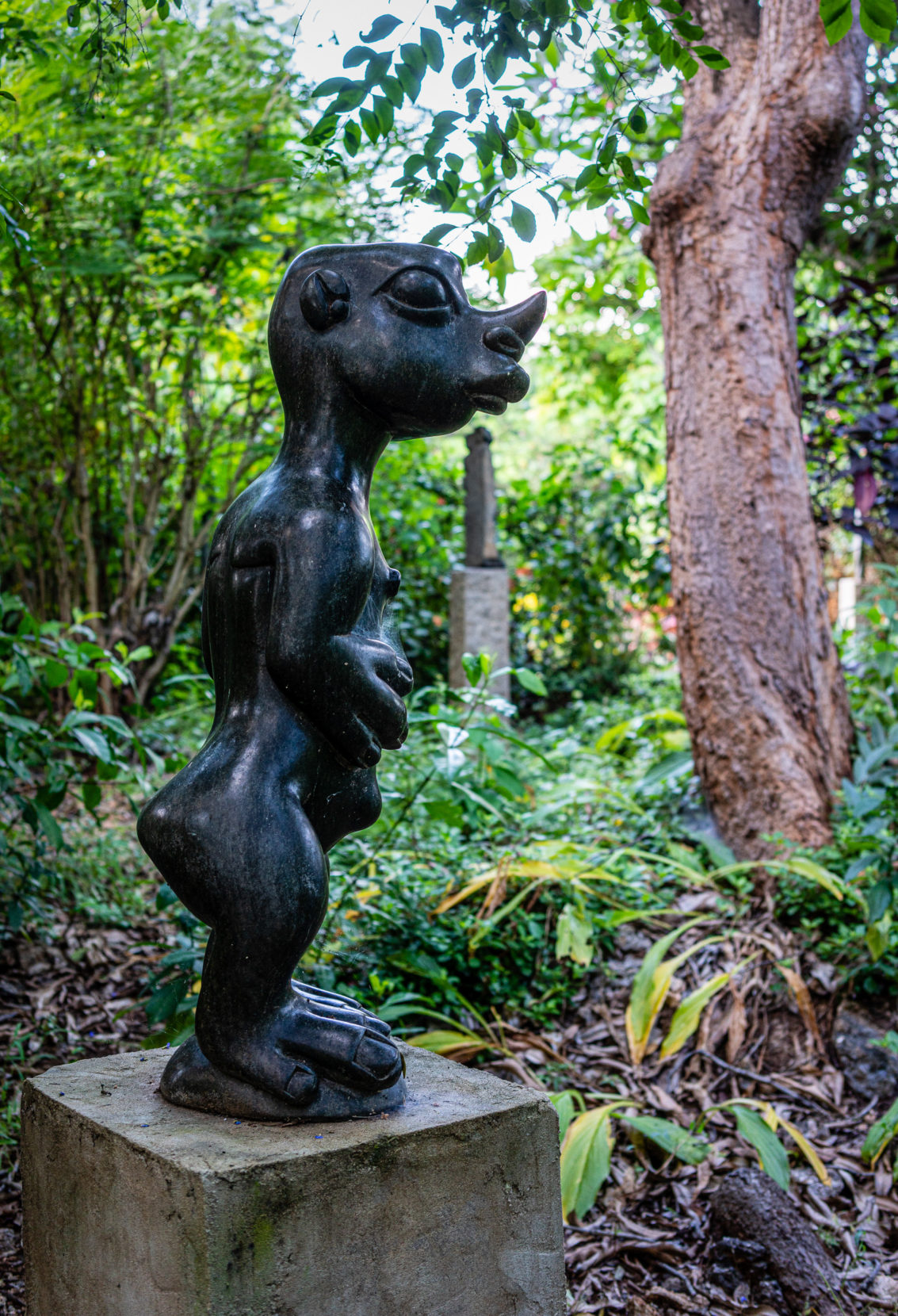
Carved by Bernard Matemera out of serpentine stone, “The Rhino Man” is informed by the Shona belief that ancestral spirits and the natural world are both intertwined and interdependent. Photo: Bart Kamphuis.
The Rhino Man. A formidable stone sculpture whose stately horn and stout limbs, each ending in three fingers or toes, have been chiseled into existence from serpentine stone. Though only a few feet tall, he presides regally over the other sculptures that surround him.
He’s as solid as can be, but the Rhino Man is a character unmoored from time and space. He’s a carved representation of the spirit world. A glimpse into human history.
A remnant of old traditions sprinkled over the present.
~~
I arrived in Malindi in time for the morning adhan, the mosque’s call to prayer.
The coastal town, founded in the 13th century, is a maze of weather-beaten houses, hotels, and shops, held upright by the echoes of ancient Swahili civilizations. Woven baskets, sun hats, and handbags hang in boxy kiosks. Over there is the mall. The museum. The mosque.
Behind it all lies the Indian Ocean — a sparkling blue that lulls and ebbs and flows, where each morning wooden fishing boats are silhouetted against the sky’s first blush.
Malindi today is religiously diverse, yet its Islamic influences shine through. Not just in the dress and customs of the people but also in some of their beliefs — myths of men who are half beast, of cats that can talk, of people who walk into the ocean in the middle of the night to convene with the devil.
The Ndoro Sculpture Garden is tucked curiously between the tourist hotels and the vacation villas — an unassuming, easy-to-miss spot with a small dark gate beneath a canopy of trees. This alfresco art gallery exhibits the work of a particular group of Zimbabwean artists — artists whose spiritual themes and preoccupations had lured me 350 miles from my home.
When I arrived, I was invited inside by a soft-spoken woman with glasses and short, graying hair. She walked with a spring in her step, despite the afternoon heat, and introduced herself as Carola Rasmussen — the gallery’s founder.
We started our tour by the front gate, at the foot of a path that spiraled its way through the gallery, between the trees and stone sculptures. Carola’s two companionable dogs trailed close behind. Above, the wind whistled through the leaves.
Carola lived in Zimbabwe for years, working as a journalist. During that time she became immersed in Shona art — particularly the carved stone sculptures made by the Bantu-speaking Shona people of southern Africa.
These carvings are an intrinsic part of the vibrant Shona culture — an art form that’s been produced for centuries as an expression of the always present, vitally important spirit world. Long before colonialism stained Africa, spiritual beliefs were shared by Bantu-speaking communities across the continent — including my ancestors, the Ameru. Today, Shona sculptures are some of the last remaining physical representations of ancient Bantu beliefs.
Over the years Carola collected pieces that she fell in love with. Many of the sculptures at the Ndoro Sculpture Garden were created by a community of artists known as the Tengenenge Collective.
Tengenenge means “the beginning of the beginning.”
~~
In 1963, Bernard Matemera, a headman’s son, spent his days working as a tractor driver on a struggling tobacco farm in British-colonized Zimbabwe. At night, his dreams were visited by otherworldly beings. It was on the farm, called Tengenenge, that he began using stone, a chisel, and a pick to bring his visions to life, forging a unique artistic style in the process.
Like many of his contemporaries, Matemera was inspired by the Shona belief in ancestral spirits. The Shona are the largest ethnic group in Zimbabwe; their cultural influence is felt more widely there than any other. Matemera’s sculptures, such as the Rhino Man, depict the form the Shona spirits are believed to take — creatures that are part human, part animal.
He’s a carved representation of the spirit world. A glimpse into human history.
Over the years other artists joined Matemera on the farm, which was rich with serpentine stone — a semi-soft, green-brown rock that’s both beautiful and relatively easy to carve. The sculptor Crispin Chakanyuka saw its artistic potential, and in 1966 co-founded the Tengenenge Collective with Matemera and the farm’s owner, Tom Blomefield.
Matemera died in 2002, but some of his last works are exhibited in the Ndoro Sculpture Garden. They include a series of intricately carved sculptures of heads with elongated foreheads, set on tall, heavy blocks of stone. According to the Shona, Carola says, “we all walk around with our auras floating above our heads.”
Elsewhere I saw carved tortoises on steps, owls and other birds, elephants, and a hare worshiping beneath a tree. There were exquisitely carved human faces too, scattered on the ground, peeking out from the grass. Close by was a large stone rendering of two people cradling a child in their arms. In another section, a group of people in animated conversation had been chiseled from a single slab of black rock.
Within the Shona belief system is an acknowledgement that all things — living and nonliving — have a spirit. This animistic veneration of nature, and the belief that the natural world is intertwined with the spirit world, vibrates throughout the gallery.
It felt familiar to me. The belief in life after death and the sacred nature of the physical world echo through the history of Bantu-speaking communities in Africa, including the Ameru. Through the carved stone in this gallery, I could see shadows of shared beliefs and hear whispers of mirrored cultures. An ancient Africa. A living Bantu spirituality. They were everywhere.
Dollops from the universe.
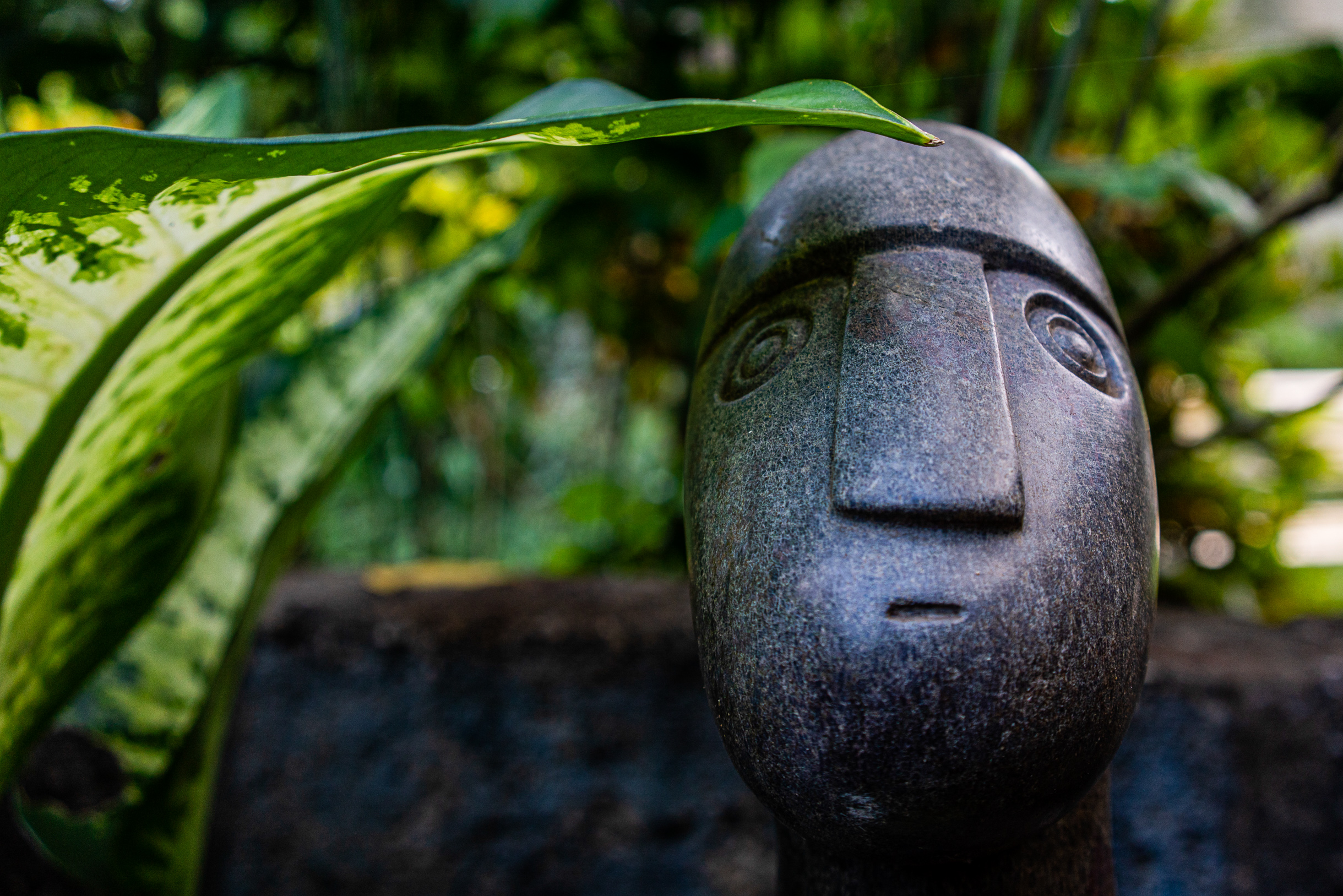
A Shona stone sculpture at the Ndoro Gallery. The Shona are the largest tribe in Zimbabwe, and from whom the country’s name is derived — “Zimbabwe” meaning “house of stone,” due to the Shona’s rich history of stone working. Photo: Bart Kamphuis.
~~
Our people lived on a gourd-shaped island called Mbwaa, my mother would say. On this island, where the ground was brushed with the beige and blush hues of sand and coral, the people fished and worked iron. When the tide would depart, women and children would comb the muddy pools for cowry shells to string around their waists as the men stood watch for the water’s return.
On the island there were many years of good health and good fortune. But one day a peculiar tribe — wearing red clothes and carrying guns and curved swords — arrived on Mbwaa. And invaded it. They were called the Nguu-Ntune, or the Red People, a fair-skinned group that historians believe to have been of Arab descent.
The Red People soon took the Ameru captive. When our ancestors asked for their freedom, their captors subjected them to a series of impossible tests, much as Moses and the Israelites had been in the Bible story. One trial required the Ameru to find and bring back a black bull that excreted white dung. Another asked them to craft a divine spear that would “pierce the sky.”
It soon became clear that the Red People did not intend to release them. So under the cloak of darkness, our ancestors quietly gathered together and slipped off the island.
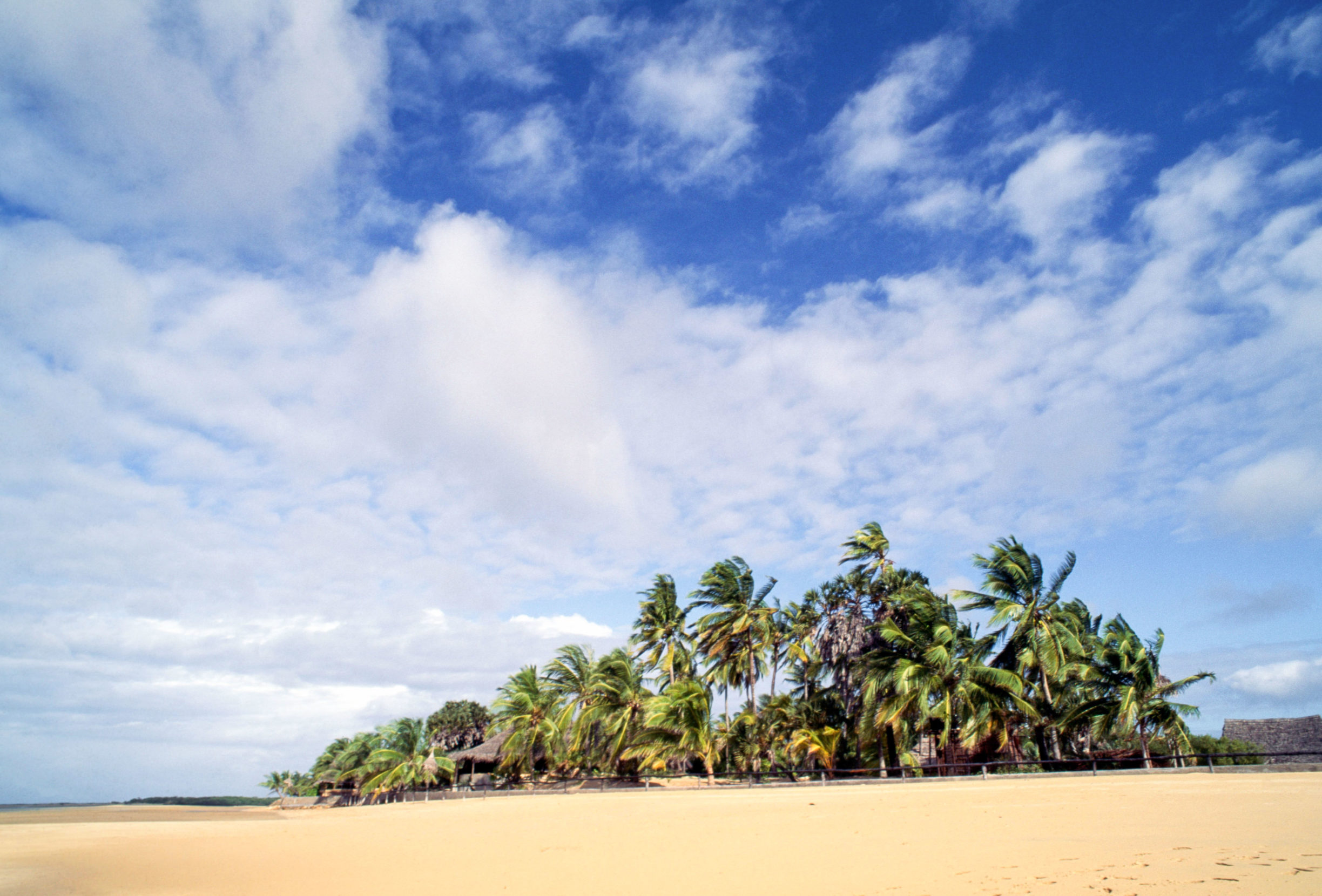
The beaches of present-day Manda Toto, an isle in the Lamu Archipelago, where the gourd-shaped island of Mbwaa — original home of the Ameru people — might have been located. Photo: DeAgostini / Alamy.
They journeyed over vast lands, carrying their traditions and keeping them close. They eventually found sanctuary on the slopes of a volcanic mountain. The air was chilly there — nothing like in Mbwaa, where the sun always shone — yet it was a place where they could be both safe and free.
Here the Ameru made a home for themselves. Over time their community grew and flourished. They were guided by their spiritual leaders, who helped preserve the culture and connect them with the spirit world.
But when the British arrived in Kenya, they promptly labeled our traditional practices and spiritual beliefs “pagan” and “superstition.” They implemented laws against them and made the possession of religious artifacts illegal.
The Ameru tried to hide their spiritual leaders and carvings from European missionaries and the colonial police. But it would not be enough. They were forced to give up their sculptures and artwork, renounce their beliefs, and observe Christian ones. Western culture became a mandatory part of their life.
As their cultural artifacts were taken away from them and scattered around the globe, their spiritual practices slowly began to fade and be forgotten, like a “pagan” skin shed and replaced by colonial religions and ways of life.
These losses amounted to an erasure of Ameru history. The legend of Mbwaa was one of the few remaining fragments from our people’s past to survive the withering of time in a new world.
They’d lean in as close to their grandmother as they could get, to hear the story of who they were and how everything began.
When my mother told us this story, pouring it into the next generation, we found that we were growing into the limbs of living libraries. Oral tradition introduced us to reservoirs of ancient histories, of poetry and song and the spirits of our ancestors — even as our hands cupped empty.
~~
Carola and I walked over brown leaves that crumbled beneath our feet. The sun winked in and out through the branches; the shapes of black and green stone peeked between the trunks. And I saw, all around me and above me, the modern physical manifestations of an ancient spirit world.
When we reached the end of the spiral path, I saw the words “House of Faces” scribbled in white paint on a wall. There, stone sculptures of women bloomed toward the sun, their thick hair wild and free in the crystalline light. They congregated in pairs, sometimes more, eyes closed, faces tilted into a brilliant efflorescence — as though lassoing the sun’s bright gaze so that it shone upon them.
I walked among them, bending down every so often to study the wave of a coiled strand, a deftly curved chin, a raised brow. Something about the way these women were represented — the sense of devotion that surrounded these carvings — made me think of the different ways in which traditional poetry, prayer, and ways of dealing with death have been expressed elsewhere in my country.
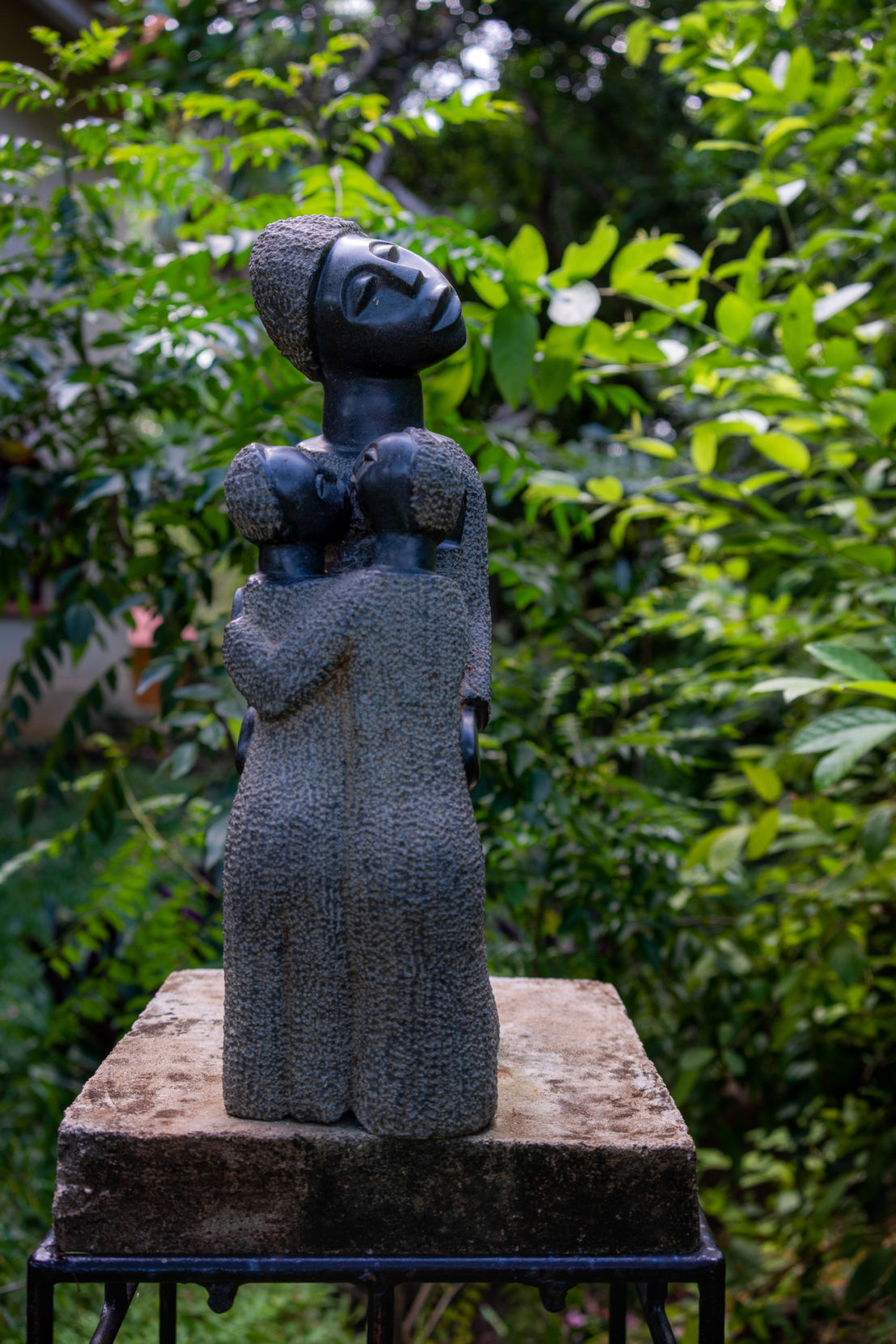
The sculptures at this outdoor gallery represent a spiritual devotion that for centuries tethered individuals to communities, eased the burden of life, and helped people reckon with death. Photo: Bart Kamphuis.
For the Akamba tribe of eastern Kenya, faith found voice in poetry, each lilting word and line of verse springing from wherever one’s heart stood at that particular moment. Their faith had no notion of a heaven or a hell. Prayer was not a means to salvation, but a soulful hymn.
Other Kenyan communities, like the Abanyole in the west, would light a ceremonial fire, called an esitioli, to keep the spirits of their departed warm on their journey to the afterlife. The coastal Mijikenda carved wooden memorial statues, known as vigango, for their dead and placed them in the home of the deceased, so that the grieving could keep their beloved close to them.
These spiritual rituals, built over centuries, made the people who they were. That anchored them to the earth they stood on. That created a community, easing the burden of existence that weighs so heavily upon each individual.
I could see shadows of shared beliefs and hear whispers of mirrored cultures. An ancient Africa.
So when the British cruelly denigrated and restricted these beliefs, the hills of our tribal rituals and the valleys of our chanted prayers were blackened. In impassioned campaigns, missionaries and colonial officers in Kenya raged against African spiritual practices, preaching that evil was anything that was “other.”
“Other,” however, was all the African communities were.
~~
Near the end of the tour I took a last glance into the trees. For a moment, I saw a vision of our sacred land kept alive for hundreds of years — an alternate reality and history where the wisdom of the old nourishes the roots, and the branches bear fruit for the young. On this sacred land our ancestors live on, remembered by all and honored for the blessings they’ve shared.
Then — in a blink — the vision was gone. I was back in the gallery, and Carola had concluded our tour.
At the gift shop I picked up a small memento — a serpentine sculpture of a naked woman’s figure, which I chose because it resembled my own body. I held it close to my chest as I said goodbye to Carola and stepped back into the bright, salty air of Malindi, feeling as though I had in my arms a capsule of Shona history. A corporeal souvenir from the spirit world. A dollop from the universe.
But I couldn’t help wondering if I’ll ever have something like that from my own ancestors one day. If what was taken away from my people and placed in Western museums long ago could be returned. If I could ever hold a small piece of my ancestral history.
Something that says, “I came from Mbwaa.”
Peace Mundia
Peace Kathure Mundia is a writer based in Nairobi, Kenya.
Never miss a story
Subscribe for new issue alerts.
By submitting this form, you consent to receive updates from Hidden Compass regarding new issues and other ongoing promotions such as workshop opportunities. Please refer to our Privacy Policy for more information.

